new deal
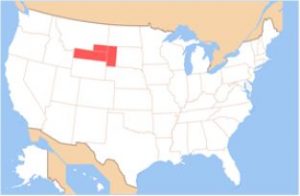 Absaroka…have you ever heard of it? No…I hadn’t either, but it was of some importance to the United States, and it would have been of some significance to me and my family had it not been a temporary situation. You see, when President Franklin D Roosevelt put “The New Deal” in place, there were a lot of people who didn’t think it was such a good deal…much like “The Green New Deal” of today. “The New Deal” was a series of programs, public work projects, financial reforms, and regulations enacted by Roosevelt in the United States between 1933 and 1939. The idea was to “help” by responding to needs for relief, reform, and recovery from the Great Depression. The plan created major federal programs and agencies, including the Civilian Conservation Corps (CCC), the Civil Works Administration (CWA), the Farm Security Administration (FSA), the National Industrial Recovery Act of 1933 (NIRA) and the Social Security Administration (SSA). They provided support for farmers, the unemployed, youth, and the elderly. The New Deal included new constraints and safeguards on the banking industry and efforts to re-inflate the economy after prices had fallen sharply. The New Deal programs included both laws passed by Congress, as well as presidential executive orders during the first term of the presidency of Roosevelt.
Absaroka…have you ever heard of it? No…I hadn’t either, but it was of some importance to the United States, and it would have been of some significance to me and my family had it not been a temporary situation. You see, when President Franklin D Roosevelt put “The New Deal” in place, there were a lot of people who didn’t think it was such a good deal…much like “The Green New Deal” of today. “The New Deal” was a series of programs, public work projects, financial reforms, and regulations enacted by Roosevelt in the United States between 1933 and 1939. The idea was to “help” by responding to needs for relief, reform, and recovery from the Great Depression. The plan created major federal programs and agencies, including the Civilian Conservation Corps (CCC), the Civil Works Administration (CWA), the Farm Security Administration (FSA), the National Industrial Recovery Act of 1933 (NIRA) and the Social Security Administration (SSA). They provided support for farmers, the unemployed, youth, and the elderly. The New Deal included new constraints and safeguards on the banking industry and efforts to re-inflate the economy after prices had fallen sharply. The New Deal programs included both laws passed by Congress, as well as presidential executive orders during the first term of the presidency of Roosevelt.
The New Deal failed because Roosevelt misunderstood the cause of the Great Depression. When a doctor misdiagnoses the symptoms that present themselves, the doctor cannot prescribe the right medicine to cure the disease of a patient. Similarly, Roosevelt prescribed “The New Deal” to cure the economy of the United States from the Great Depression. Roosevelt’s “medicine” did not work because his administration failed to recognize the true causes of the Great Depression and therefore prescribed the wrong medicine. Roosevelt assumed that the free market, and not the government caused the Great Depression. Roosevelt believed the Great Depression was partly caused by poor investments and stock manipulations by rich people. To complicate matters, he blamed the Great Depression on bankers, speculators, and journalists. In reality, the causes of the Great Depression boiled down to three major causes…which explain why there was a banking crisis, why the  stock market declined, why exports vanished, why trading partners were upset, why major industries collapsed, and why there was uncertainty on the administration’s policies. These three explanations of the causes contrast with Roosevelt’s assumption that the private, not the public sector caused the problem. First, the negative consequences of World War I, increasing debt from less than $2 billion to over $20 billion, while at the same time, US loans to Europe amounted to over $10 billion. Second, the Smoot-Hawley Tariff Act…the highest tariff in US history, which affected over 3,000 imported items and even increased taxes on some items. As a result of those high tariffs, foreign goods became less competitive and similar domestic goods more competitive. Third, the Federal Reserve did not prevent a banking crisis, but rather helped cause one. It was argued that the economic contraction was exacerbated because of the bank failures and the massive withdrawals of currency from the financial system while the Federal Reserve did not provide the necessary liquidity that the system required.
stock market declined, why exports vanished, why trading partners were upset, why major industries collapsed, and why there was uncertainty on the administration’s policies. These three explanations of the causes contrast with Roosevelt’s assumption that the private, not the public sector caused the problem. First, the negative consequences of World War I, increasing debt from less than $2 billion to over $20 billion, while at the same time, US loans to Europe amounted to over $10 billion. Second, the Smoot-Hawley Tariff Act…the highest tariff in US history, which affected over 3,000 imported items and even increased taxes on some items. As a result of those high tariffs, foreign goods became less competitive and similar domestic goods more competitive. Third, the Federal Reserve did not prevent a banking crisis, but rather helped cause one. It was argued that the economic contraction was exacerbated because of the bank failures and the massive withdrawals of currency from the financial system while the Federal Reserve did not provide the necessary liquidity that the system required.
As people became more and more agitated about the unsuccessful New Deal, an idea began to form…secession. One of the leaders of the secessionist movement was A R Swickard, the street commissioner of Sheridan, Wyoming, who appointed himself “governor” and started hearing grievances in the “capital” of Sheridan. The new state was to be called Absaroka, which means “children of the large-beaked bird.” They planned secession in 1939. This region largely belongs to the Crow people and the Sioux, according to the Treaty of Fort Laramie (1851). Absaroka is also the namesake of the Absaroka mountain range. The area involved was the entire northern part of Wyoming, the western part of South Dakota, including the Black Hills, and the southeastern corner of Montana. Increasing tourism to the region was a motivation for the proposed state because Mount Rushmore (constructed 1927–1941) would be within Absaroka according to some plans.
The region’s complaints came from ranchers and independent farmers in remote parts of the three states, who  resented the New Deal and Democratic control of state governments, especially the government of Wyoming. In preparation for state secession, state automobile license plates bearing the name were distributed, as well as pictures of Miss Absaroka 1939. The movement was unsuccessful and fairly short-lived. The chief record of its existence comes from the Federal Writers’ Project, which included a story about the plan as an example of Western eccentricity. Oh those eccentric Westerners!! Imagine wanting to limit government, high taxes, and strict laws and mandates!! What were they thinking? Freedom, limited government, capitalism vs socialism…yep among other things, that’s what they were thinking.
resented the New Deal and Democratic control of state governments, especially the government of Wyoming. In preparation for state secession, state automobile license plates bearing the name were distributed, as well as pictures of Miss Absaroka 1939. The movement was unsuccessful and fairly short-lived. The chief record of its existence comes from the Federal Writers’ Project, which included a story about the plan as an example of Western eccentricity. Oh those eccentric Westerners!! Imagine wanting to limit government, high taxes, and strict laws and mandates!! What were they thinking? Freedom, limited government, capitalism vs socialism…yep among other things, that’s what they were thinking.
 When times get tough, new ideas are needed to get people through them. The Great Depression put many people out of work. Times don’t get much tougher than that. The government decided to try something new. The project that was put forward was the Federal Writers’ Project (FWP). The idea was to fund written work and support writers during those dark days. The project was deigned to be in operation from July 27, 1935 to October 1939. It was part of the Works Progress Administration, a New Deal program.
When times get tough, new ideas are needed to get people through them. The Great Depression put many people out of work. Times don’t get much tougher than that. The government decided to try something new. The project that was put forward was the Federal Writers’ Project (FWP). The idea was to fund written work and support writers during those dark days. The project was deigned to be in operation from July 27, 1935 to October 1939. It was part of the Works Progress Administration, a New Deal program.
Of course, this was not really designed to allow people to explore the idea of becoming a writer, but rather to ease the plight of the unemployed writer, and anyone who could qualify as a writer such as a lawyer, a teacher, or a librarian. As the Roosevelt Administration ironed out the details of the New Deal, the administration and writers’ organizations and persons of liberal and academic persuasions felt that somehow, they could come up with more appropriate work situations for this group, the writers, other than blue collar jobs on construction projects. The final project was for one all the arts, which was called Federal One. As part of President Roosevelt’s Second New Deal, Federal One was divided into five specialties…writers, historical records, theater, music, and art. Each specialty was headed by professionals in that field.
The Federal Writers Project was first operated under journalist and theatrical producer Henry Alsberg, and later John D Newsome, who were charged with employing writers, editors, historians, researchers, art critics, archaeologists, geologists and cartographers. Some 6,600 individuals were employed by the project compiling 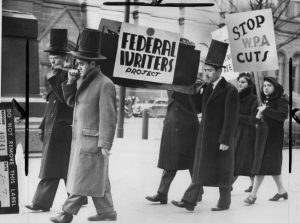 local and cultural histories, oral histories, children’s books, and other works. The most well-known of these publications were the 48 state guides to America known as the American Guide Series. These books contained detailed histories of each state with descriptions of every city and town. They also contained a state’s history and culture, automobile tours of important attractions, and a portfolio of photographs. In each state a Writer’s Project staff was formed with editors and field workers. Some offices had as many as 150 people working, a majority of whom were women. Staff also included several well-known authors of the time and the program helped to launch the literary careers of others.
local and cultural histories, oral histories, children’s books, and other works. The most well-known of these publications were the 48 state guides to America known as the American Guide Series. These books contained detailed histories of each state with descriptions of every city and town. They also contained a state’s history and culture, automobile tours of important attractions, and a portfolio of photographs. In each state a Writer’s Project staff was formed with editors and field workers. Some offices had as many as 150 people working, a majority of whom were women. Staff also included several well-known authors of the time and the program helped to launch the literary careers of others.
Though the project produced useful work in the many oral histories collected from residents throughout the United States, it had its critics from the beginning, with many saying it was the federal government’s attempt to “democratize American culture.” Though most works were not political, some writers who supported political themes sometimes voiced their positions in their writings. This led some state legislatures to strongly oppose some projects and in a few states the American Guide Series books were printed only minimally. As the Project continued into the late thirties, criticism continued and several Congressmen just wanted to shut the project down. In October 1939, federal funding for the project ended, due to the Administration’s need for a larger defense budget. It was decided that the project could continue under state sponsorship, but even that ended in 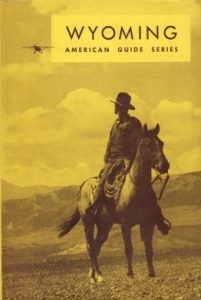 1943. I’m sure that was due to World War II, and all that was needed to be poured into the war effort.
1943. I’m sure that was due to World War II, and all that was needed to be poured into the war effort.
While I am not really a fan of the government manufacturing jobs, I think that some of the great writings that came out of the Federal Writers Project, made this project one of the better government funded job ideas. During its existence, the project included a rich collection of rural and urban folklore, first-person narratives from people coping with the Depression, studies of social customs of various ethnic groups, and over 2,300 first person accounts of slavery. In documenting the common people, a number of books emerged from writers on the project including Jack Conroy’s The Disinherited and John Steinbeck’s classic The Grapes of Wrath. While this project was certainly unorthodox, it makes you wonder if we would have missed out of some great books, had it not been for this program. When the project ended, there were actually protests in an effort to keep it going, but it had run its course, and in 1943, it ended.
 These days, every military veteran has available to them, a compensation package to thank them for their service. Returning servicemen have access to unemployment compensation, low-interest home and business loans, and…most importantly, funding for education, but this was not always the case. In fact, there was a time when returning veterans had to fight for bonuses they were supposed to receive, which brought about the 1932 Bonus March, in which 20,000 unemployed veterans and their families flocked in protest to Washington. I think most of us would agree that our veterans should not have to fight for the things promised to them for their service, after they have already spent time fighting for their country.
These days, every military veteran has available to them, a compensation package to thank them for their service. Returning servicemen have access to unemployment compensation, low-interest home and business loans, and…most importantly, funding for education, but this was not always the case. In fact, there was a time when returning veterans had to fight for bonuses they were supposed to receive, which brought about the 1932 Bonus March, in which 20,000 unemployed veterans and their families flocked in protest to Washington. I think most of us would agree that our veterans should not have to fight for the things promised to them for their service, after they have already spent time fighting for their country.
President Franklin D Roosevelt was responsible for the sweeping New Deal reforms, many of which were really not good for this nation or its people, but there was one part of that legislation that has been a good thing for returning veterans…the G.I. Bill. On this day June 22, 1944, President Franklin D Roosevelt signed the G.I. Bill. It was an unprecedented act of legislation designed to compensate returning members of the armed services, known as G.I.s, for their efforts in World War II. The G.I. Bill…officially the Servicemen’s Readjustment Act of 1944…was proposed in an effort to avoid a relapse into the Great Depression after the war ended. The American Legion, a veteran’s organization, successfully fought for many of the provisions included in the bill, which gave returning servicemen the compensations they now have. By giving veterans money for tuition, living expenses, books, supplies and 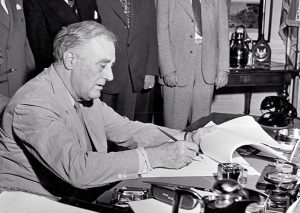 equipment, the G.I. Bill effectively transformed higher education in America. Before the war, college had been an option for only 10-15 percent of young Americans, and university campuses had become known as a haven for the most privileged classes. This was not what America was supposed to be about. By 1947, the contrast was striking. Veterans made up half of the nation’s college enrollment. Three years later, nearly 500,000 Americans graduated from college, compared with 160,000 in 1939. Sure, they had to serve their country, but for many young people, this was not only what they felt was their duty, but it also became a scholarship program.
equipment, the G.I. Bill effectively transformed higher education in America. Before the war, college had been an option for only 10-15 percent of young Americans, and university campuses had become known as a haven for the most privileged classes. This was not what America was supposed to be about. By 1947, the contrast was striking. Veterans made up half of the nation’s college enrollment. Three years later, nearly 500,000 Americans graduated from college, compared with 160,000 in 1939. Sure, they had to serve their country, but for many young people, this was not only what they felt was their duty, but it also became a scholarship program.
As educational institutions opened their doors to this diverse new group of students, overcrowded classrooms and residences prompted widespread improvement and expansion of university facilities and teaching staffs. The bill was not only good for the veterans, but also for the economy, as more teaching jobs were created. An array of new vocational courses were developed across the country, including advanced training in education, agriculture, commerce, mining and fishing…skills that had previously been taught only informally. Some of these classes are responsible for some of the jobs that everyday Americans, even those without college educations have held. Jobs such as mining, and farming, and even fishing became commonplace.
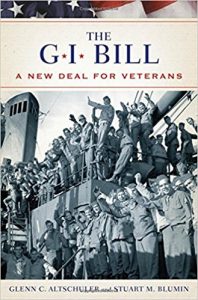
The G.I. Bill became one of the major forces for economic expansion in America that lasted 30 years after World War II. Only 20% of the money set aside for unemployment compensation under the bill was given out. Most veterans found jobs or pursued higher education. Low interest loans enabled millions of American families to move out of cities and buy or build homes outside the city, changing the face of the suburbs. Over 50 years, the impact of the G.I. Bill was enormous, with 20 million veterans and dependents using the education benefits and 14 million home loans guaranteed, for a total federal investment of $67 billion. Among the millions of Americans who have taken advantage of the bill are former Presidents George H.W. Bush and Gerald Ford, former Vice President Al Gore and entertainers Johnny Cash, Ed McMahon, Paul Newman and Clint Eastwood, and closer to home, my brother-in-law, Ron Schulenberg, as well as my nephew, Allen Beach and soon, his wife, Gabby.

